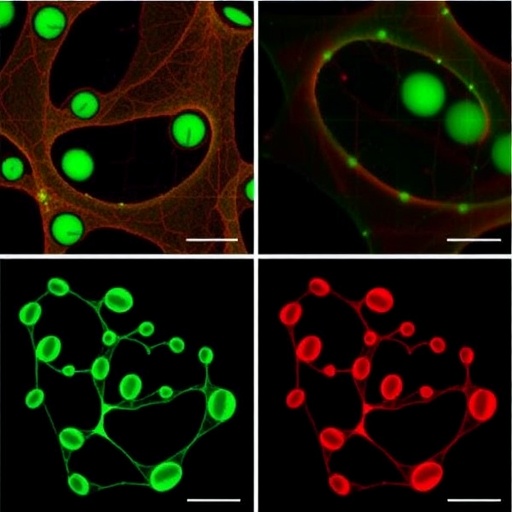
Credit: Washington University in St. Louis
Imagine a physician in a rural or remote area who needs to send a patient's blood or urine sample to a hospital hundreds of miles away for testing. To preserve the sample's quality, it must be refrigerated throughout transport, a costly process requiring tremendous energy which may be scarce.
Using nanotechnology, a team of researchers at Washington University in St. Louis has eliminated the need for refrigeration by developing a new low-cost technique that creates a protective shield around protein biomarkers in the sample. With this method, the samples maintain 95 percent of their purity and the information on which important health-care decisions are based.
The team is led by Srikanth Singamaneni, associate professor of mechanical engineering & materials science in the School of Engineering & Applied Science; and two scientists at Washington University School of Medicine in St. Louis: Jeremiah J. Morrissey, research professor of anesthesiology; and Evan D. Kharasch, MD, PhD, the Russell D. and Mary B. Shelden Professor of Anesthesiology and professor of biochemistry and molecular biophysics. They used a nanoporous material to essentially shrink wrap protein biomarkers in blood and urine samples by growing crystals around the molecules. Then, they transferred the shrink-wrapped molecules onto standard lab filter paper. Once dry, the paper can be shipped at any temperature to a lab for testing.
"Once you are ready to analyze the sample, you extract everything from the paper back into liquid," Singamaneni said. "We showed that this method maintains the integrity of the biospecimens."
The research, recently published in Chemistry of Materials, is the first published work that uses an emerging class of nanomaterials known as metal-organic frameworks with biospecimens such as blood, urine, serum and plasma.
This inexpensive and accessible method has wide applicability, the researchers said, with the potential to be used in developing countries with limited access to health care and electricity, in rural areas with limited resources, or at off-site clinics or screenings.
More than a year ago, the team published a paper in Advanced Materials in which it grew metal-organic frameworks around antibodies attached to gold nanorods to eliminate the need for refrigeration in storing biodiagnostic chips. This method protected the antibodies for a week stored at room temperature, though required that the protective layers be rinsed off before use.
"We asked why we couldn't apply the same technology to preserve the biospecimen instead of preserving the biosensor," Singamaneni said. "The implementation required us to overcome a few critical hurdles because it's not the same as preserving something that is bound to a substrate compared to what's in a solution."
To test their technique, the team used artificial urine samples spiked with neutrophil gelatinase-associated lipcalin (NGAL), a biomarker for acute kidney injury; and blood samples spiked with CA-125, a biomarker for ovarian cancer. The team mixed the samples with precursors of the nanoporous material ZIF-8 and let them dry on the paper at room temperature. Using standard bioanalytical techniques, the team determined that the samples with ZIF-8 encapsulation had more than 95 percent of NGAL preserved.
The team also tested the method with urine samples from three patients with acute kidney injury. The samples stored at room temperature retained more than 90 percent of NGAL. Control samples without ZIF-8 encapsulation had less than 30 percent of NGAL preserved.
Similarly, the blood samples spiked with CA-125 and encapsulated by ZIF-8 showed about 85 percent preservation, while those without the encapsulation showed 50 percent or less preservation.
To test the method in a real-world application, the researchers put the paper with the dried samples in a standard envelope and sent them via regular mail to a colleague in California, who mailed them back to Washington University. The researchers tested the samples after the 10-day round trip and found up to 90 percent of the NGAL was preserved.
The team plans to test the method with other biomolecules to create more potential applications for both research and clinical settings, as well as to develop a biopreservation kit that would allow patients to prepare their own dried blood or urine samples to send to labs for testing.
To ensure that this method gets to resource-limited settings, the team has worked with the university's Office of Technology Management to patent the technology and plans to develop it into a product available to the health-care industry. Ultimately, they envision a biopreservation kit that would include the ZIF-8 precursors, paper strips and other materials needed to allow patients in underserved areas to prepare their own blood and urine samples and send them to hospitals or labs.
"One of our next steps is to take the technology out of the laboratory and commercialize it so that it can work to the greatest good for the greatest number of people," said Kharasch, also director of the Center for Clinical Pharmacology. "This would make it widely available in both first-world countries as well as emerging countries and in emergency situations or environmental disasters where we need to deploy people and have scarce resources."
###
Wang C, Sun H, Luan J, Jiang Q, Tadepalli S, Morrissey J, Kharasch E, Singamaneni S. "Metal-Organic Framework Encapsulation for Biospecimen Preservation." Chemistry of Materials, Feb. 1, 2017. DOI: 10.1021/acs.chemmater.7b04713.
This research was supported by funding from the Air Force Office of Scientific Research and the National Institutes of Health (R01 CA141521).
The School of Engineering & Applied Science at Washington University in St. Louis focuses intellectual efforts through a new convergence paradigm and builds on strengths, particularly as applied to medicine and health, energy and environment, entrepreneurship and security. With 94 tenured/tenure-track and 40 additional full-time faculty, 1,300 undergraduate students, 1,200 graduate students and 21,000 alumni, we are working to leverage our partnerships with academic and industry partners — across disciplines and across the world — to contribute to solving the greatest global challenges of the 21st century.
Media Contact
Erika Ebsworth-Goold
[email protected]
314-935-2914
@WUSTLnews
Original Source
https://source.wustl.edu/2018/03/simplifying-samples/ http://dx.doi.org/10.1021/acs.chemmater.7b04713




